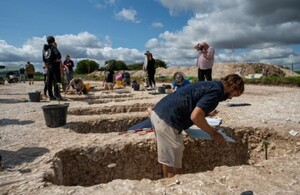Veterans and archaeologists uncover ‘richest grave this year' on final dig at Saxon cemetery
Military veterans taking part in a Defence Infrastructure Organisation (DIO) archaeological excavation of an Anglo-Saxon burial site on Salisbury Plain Training Area have uncovered the richest grave found this year.

The team get to work on the dig site at Avon Camp. Crown copyright.
The veterans, a team from Wessex Archaeology and DIO’s chief archaeologist, Richard Osgood, knew the site had the potential to yield some exciting archaeology and the final dig at the Avon Camp cemetery has not disappointed. The team has unearthed a large bone and antler comb and some iron shears, in what they describe as the richest grave uncovered this year. The items, which are from the same burial, are 1400 years old and have generated much excitement at the site.
The dig is part of a programme called Operation Nightingale which supports the health and wellbeing of military veterans. The award-winning scheme sees wounded, injured and sick service personnel and veterans taking part in archaeological digs on the Defence estate. This year, for the first time, the team is joined by members of the Army Widows’ Association, a volunteer-run organisation and charity that offers support and friendship to the widows and widowers of servicemen and women.
Minister for Defence People, Veterans and Service Families, RT Hon Andrew Murrison, said:
This dig is part of an award-winning programme that supports the health and wellbeing of wounded, injured and sick service personnel and military veterans. The excavations have yielded some fantastic artefacts of historical importance, and as we move into the final dig at this site, I would like to thank all the personnel, veterans and teams that have taken part in the archaeological digs on the Defence estate.
This year, it’s been fantastic to welcome the Army Widows association to participate in this scheme and learn more about the support they offer the widows and widowers of service personnel.

The bone and antler comb found in the richest grave uncovered at the site. Crown copyright.
DIO’s Head Archaeologist, Richard Osgood, said:
We are excited to be back at Avon Camp for this third and final time, this site has provided some incredible archaeology and allowed us to gain a real understanding of what life was like for people living on this land in the 7th century.
As well as allowing us to capture this historically important information from a site that is listed on the Heritage at Risk Register, we can provide information that supports the stewardship of the estate, which helps us to balance preservation with the needs of what is also a military training area.
The benefits for the veterans who attend these digs are incredible. They return again and again for the experience and the kinship, and this year we are delighted to be joined by Army widows. There is something about digging in a hole in the ground and connecting with the moment-to-moment experience that is archaeology that has proven to be very healing.
The two previous digs at the 7th century burial area, which took place in 2021 and 2022, yielded some incredible artefacts including Roman coins, bronze and silver discs and a necklace made of glass beads. These earlier digs uncovered around 26 burials in 22 graves and this final excavation has helped to add some more pieces to the puzzle.
Phil Andrews from Wessex Archaeology, who oversees and supports the work of the DIO team helping to record the archaeology, said:
The aim in our final year of excavation at Avon Camp is to gain a full picture of this remarkable Anglo-Saxon cemetery and add to our understanding of rare burial enclosures we have found evidence of. Central to this is supporting the veterans to undertake the excavation and to recognise the important role they are playing in uncovering and recording the archaeology. As well as learning something new, we hope they have an enjoyable time as part of the dig team.